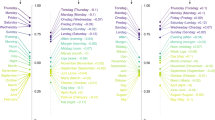Abstract
To account for a type of contextual effect on word order, some researchers propose theme-first (old things first) principles. However, their universality has been questioned due to the existence of counterexamples and the possibility of arguably rheme-first (new things first) languages. Capturing the contextual effects on theme-rheme ordering (information structure) in terms of information theory, this paper argues that word order is affected by the distribution of informativeness, an idea also consistent with counterexamples and rheme-first languages.
Access this chapter
Tax calculation will be finalised at checkout
Purchases are for personal use only
Preview
Unable to display preview. Download preview PDF.
Similar content being viewed by others
References
Knud Lambrecht. Information Structure and Sentence Form: Topic, focus, and the mental representations of discourse referents. Cambridge University Press, 1994.
Vilém Mathesius. A Functional Analysis of Present Day English on a General Linguistic Basis, edited by Josef Vachek. The Hague: Mouton, 1975.
Jan Firbas. On defining the theme in functional sentence analysis. Travaux Linguistiques de Prague, 1:267–280, 1964.
M. A. K. Halliday. An Introduction to Functional Grammar. London: Edward Arnold, 1985.
Nobo N. Komagata. A Computational Analysis of Information Structure Using Parallel Expository Texts in English and Japanese. PhD thesis, University of Pennsylvania, 1999.
Nobo Komagata. Information structure in subordinate and subordinate-like clauses in special issue on discourse and information structure (to appear). Journal of Logic, Language and Information, 12(3), 2003.
Petr Sgall, Eva Hajičová, and Jarmila Panevova. The meaning of the sentence in its semantic and pragmatic aspects. D. Reidel, 1986.
Marianne Mithun. Morphological and prosodic forces shaping word order. In Pamela Downing and Michael Noonan, editors, Word Order in Discourse. John Benjamins, 1995.
Doris L. Payne. Information structuring in papago narrative discourse. Language, 63(4):783–804, 1987.
Chet A. Creider and Jane T. Creider. Topic-comment relation in a verb-initial language. J. African Languages and Linguistics, 5:1–15, 1983.
Elena M. Leman. Cheyenne Major Constituent Order. Dallas, TX: Summer Institute of Linguistics, 1999.
Enric Vallduví. The informational component. PhD thesis, University of Pennsylvania, 1990.
Fred I. Dretske. Knowledge and the Flow of Information (originally published in 1981 from the MIT Press). CSLI, 1999.
I. Kruijff-Korbayová, G.J.M. Kruijff, and John Bateman. Generation of contextually appropriate word order. In Kees van Deemter and Rodger Kibble, editors, Information sharing. CSLI, 2000.
Fazlollah M. Reza. An Introduction to Information Theory (first published in 1961 by McGraw-Hill). Dover, 1994.
Christopher D. Manning and Hinrich Schütze. Foundation of Statistical Natural Language Processing. MIT Press, 1999.
Yehoshua Bar-Hillel. Language and Information. Addison-Wesley, 1964.
Frederick J. Crosson and Kenneth M. Sayre, editors. Philosophy and Cybernetics. University of Notre Dame, 1967.
Colin Cherry. On human communication: a review, a survey, and a criticism. MIT Press, 1978.
Angelica Kratzer. Stage-level and individual-level predicates. In Gregory N. Carlson and Francis Jeffry Pelletier, editors, The Generic Book, pages 125–175. University of Chicago Press, 1995.
Nomi Erteschik-Shir. The syntax-focus structure interface. In Peter W. Culicover and Louise McNally, editors, Syntax and Semantics, Vol. 29: The limits of syntax, pages 211–240. Academic Press, 1998.
Mark Steedman. Information structure and the syntax-phonology interface. Linguistic Inquiry, 31(4):649–689, 2000.
Doris L. Payne. Verb initial languages and information order. In Pamela Downing and Michael Noonan, editors, Word Order in Discourse. John Benjamins, 1995.
Pamela Downing. Word order in discourse: By way of introduction. In Pamela Downing and Michael Noonan, editors, Word Order in Discourse. John Benjamins, 1995.
Knud Lambrecht. On the status of SVO sentences in French discourse. In Russell S. Tomlin, editor, Coherence and Grounding in Discourse, pages 217–262. John Benjamins, 1987.
Marianne Mithun. Is basic word order universal? In Doris L. Payne, editor, Pragmatics of Word Order Flexibility, pages 15–62. John Benjamins, 1992.
Doris L. Payne. Nonidentifiable information and pragmatic order rules in ‘o’odham. In Doris L. Payne, editor, Pragmatics of Word Order Flexibility, pages 137–166. John Benjamins, 1992.
Russell S. Tomlin and Richard Rhodes. Information distribution in Ojibwa. In Doris L. Payne, editor, Pragmatics of Word Order Flexibility, pages 117–136. John Benjamins, 1992.
Ellen F. Prince. Toward a taxonomy of given-new information. In Peter Cole, editor, Radical Pragmatics, pages 223–256. Academic Press, 1981.
Author information
Authors and Affiliations
Editor information
Editors and Affiliations
Rights and permissions
Copyright information
© 2003 Springer-Verlag Berlin Heidelberg
About this paper
Cite this paper
Komagata, N. (2003). Contextual Effects on Word Order: Information Structure and Information Theory. In: Blackburn, P., Ghidini, C., Turner, R.M., Giunchiglia, F. (eds) Modeling and Using Context. CONTEXT 2003. Lecture Notes in Computer Science(), vol 2680. Springer, Berlin, Heidelberg. https://doi.org/10.1007/3-540-44958-2_16
Download citation
DOI: https://doi.org/10.1007/3-540-44958-2_16
Published:
Publisher Name: Springer, Berlin, Heidelberg
Print ISBN: 978-3-540-40380-7
Online ISBN: 978-3-540-44958-4
eBook Packages: Springer Book Archive




